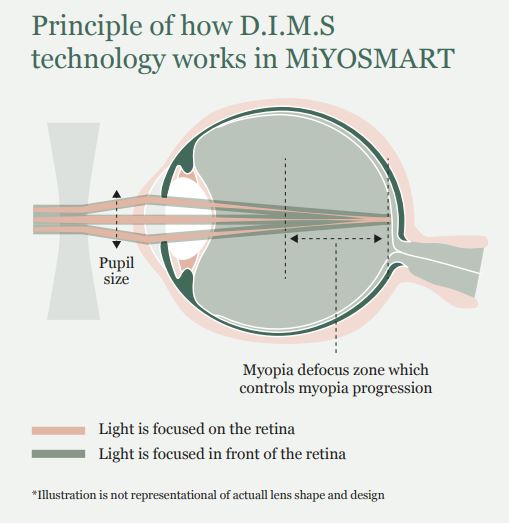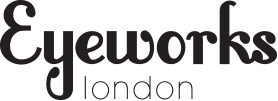
In a myopic eye the distance vision is blurred.
Light rays from distance objects are focused in front of the retina rather than on the retina. This is usually because the eye has grown too long.
In some children as they grow the eyes will grow in length too. The elongation of the eyes will cause the myopia to progress.
Therefore, myopia will progress more in late childhood and teenage years and myopia management will be more effective in this age range.
What is myopia management?
Myopia management does not cure or reduce myopia, but aims to slow down the rate at which it
gets worse. The eye grows rapidly until early adulthood, so myopia management will usually be
continued until at least 17 years old. If myopia management is stopped before the eye has stopped growing, the myopia may start to get worse again.
Why does myopia matter?
There are two reasons why the amount of myopia matters.
- The first reason is obvious; the higher the myopia the more dependence on glasses or contact lenses. This can be inconvenient and expensive.
- The second reason is that large amounts of myopia can affect the health of the eyes. The greater the myopia the longer the eye will be. A physically long eye creates tension on the structures of the eye. Consequently, a myopic eye is more at risk of retinal detachment and maculopathy. Studies have shown that a 1 dioptre increase in myopia will double the risk of maculopathy.
Risk of eye condition with myopia level
| Prescription |
Retinal Detachment | Myopia Maculopathy |
| -1.00 to -3.00 |
3.1 | 2.2 |
| -3.00 to -5.00 |
9 | 9.7 |
| -5.00 to -7.00 |
21.5 | 40.6 |
| < -7.00 |
44.2 | 126.8 |
Therefore, every dioptre counts and intervening before the myopia progresses will be beneficial for the health of the eyes as well as reduce the dependence on glasses.
Who is at risk of myopia?
Family History
One myopic parent increases risk by three-fold, while two myopic parents means you are six times more likely to develop myopia.
Ethnicity
East Asian descent is linked to myopia.
Visual Environment
Less than 90 minutes outdoors per day increases risk.
Near Vision Efficiency
Children whose eyes tend to over converge and have a focusing lag when reading are more a risk of myopia. These two issues can be checked by the optometrist.

Age Appropriate Prescription
Children are born approximately +2.00 longsighted and as their eyes grow, they grow out of their longsightedness. Children with +0.50 or less at age 6-7 are at risk of developing myopia.
Myopia management options available at Eyeworks London

It is not fully understood but under-correction of the peripheral vision reduces the progression of myopia.
Hoya optical lens manufacturers have collaborated with Hong Kong Polytechnic to develop a lens called MiYOSMART. The lens has a peripheral defocus (to reduce myopia progression) while simultaneously providing clear vision. They have called this technology DIMS (Defocus Incorporated Multiple Segments).
The MiYOSMART lens was trialled in a 2 year study where participants had an average of a 60% reduction in myopia progression. The lens is a new non invasive myopia management solution. It is safe and convenient with the same look and experience as an ordinary spectacle lens.
MiSight contact lenses
Soft contact lenses have recently been developed especially for myopia management. These contact lenses have a dual focus like multifocal lenses that create a peripheral defocus. MiSight lenses from Coopervision reduce myopia progression on average 59%. Theses lenses are a daily disposable lens and are suitable for children as young as 8.
Simple at home considerations for myopia management
Time Spent Outdoors
Spending more that 90 minutes per day outside helps reduce the risk of myopia.
Being Mindful Of Close Work
There is an association with prolonged near work and myopia. It is not to say that reading and school work should be discouraged. Instead being mindful of regular breaks and minimising recreational screen time will helpful to limit myopia progression.
Alternative myopia management options (not currently available at Eyeworks London)
Orthokeratology
Treatment Overnight contact lenses
Effectiveness 60% reduction in progression
Availability Selected UK Optometrists
Atropine
Treatment Eye drops
Effectiveness 80% reduction in progression
Availability License pending in UK

Making Myopia Management Routine
Myopia is such a common eye condition yet Myopia Management remains a speciality in Optometry. It is usually only offered in specialised clinics in specific appointment slots. We feel Myopia Management Consultations should be offered as part of a routine eye test - so no special appointments or extra charges apply. For an appointment please call 02075842697 or book online
References
Bullimore MA, Ritchey ER, Shah S, Leveziel N,Bourne RRA, Flitcroft DI. The Risks and Benefits of Myopia Control.
Ophthalmology. 2021 Nov;128(11):1561-1579. doi: 10.1016/j.ophtha.2021.04.032.
Epub 2021 May 4. PMID: 33961969.
Bullimore MA, Brennan NA. Myopia Control: Why Each Diopter Matters. Optom Vis Sci 2019 96(6):463-465
Miyosmart Lam CSY, Tang WC, Tse DY, et al. Defocus Incorporated Multiple Segments (DIMS) spectacle lenses slow myopia progression: a 2-year randomised clinical trial. Br J Ophthalmol 2020 104(3):363-368
Misight Chamberlain P,
Peixoto-de-Matos SC, Logan NS, et al. A 3-year randomized clinical trial of
MiSight lenses for myopia control. Optom Vis Sci 2019 96(8):556-567
Dhakal
R, Shah R, Huntjens B, et al. Time spent outdoors as an intervention for myopia
prevention and control in children: an overview of systematic reviews. Ophthal
Physiol Opt 2022 42(3):545-558
Xiong
S, Sankaridurg P, Naduvilath T, et al. Time spent in outdoor activities in relation
to myopia prevention and control: a meta‐analysis
and systematic review. Acta Ophthalmol 2017 95(6):551-566
Foreman
J, Salim AT, Praveen A, et al. Association between digital smart device use and
myopia: a systematic review and meta-analysis. Lancet Digit Health 2021
3(12):e806-e818
Gajjar
S, Ostrin LA. A systematic review of near work and myopia: measurement,
relationships, mechanisms and clinical corollaries. Acta Ophthalmol 2022
100(4):376-387


